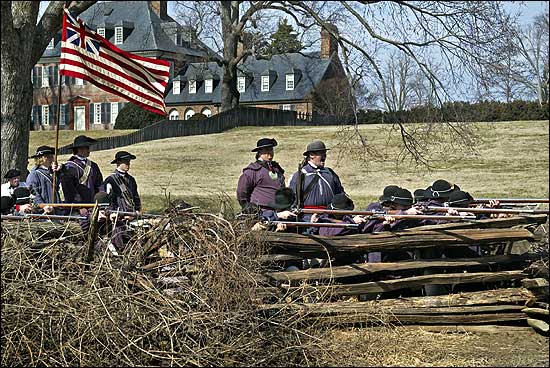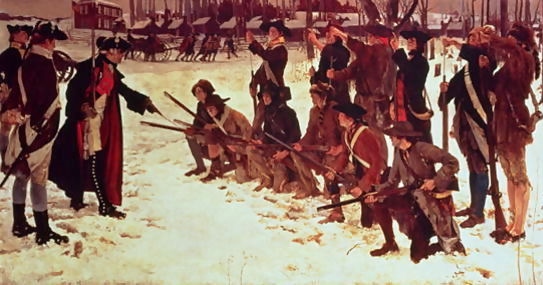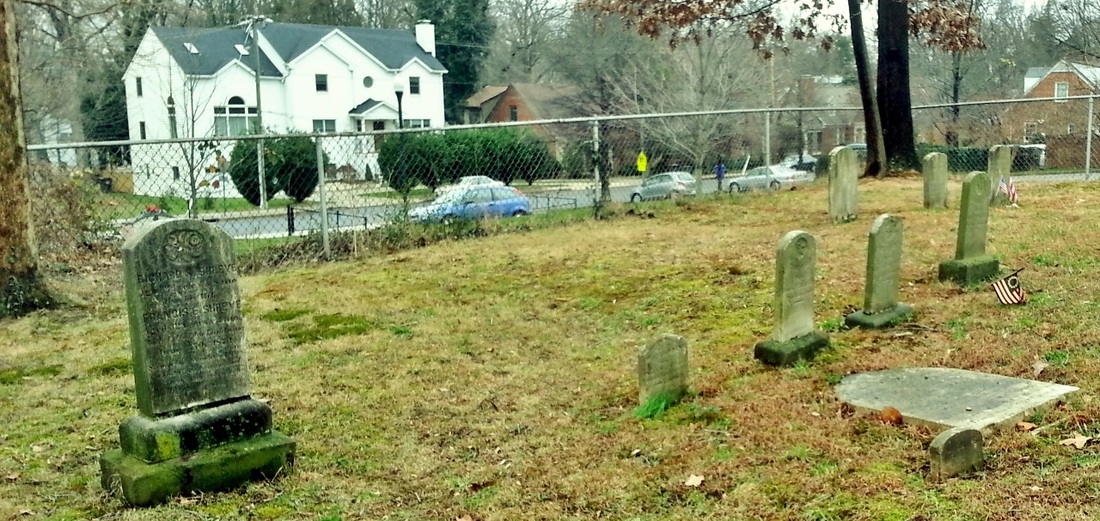
What the U.S. 6th Virginia Regiment would’ve looked like, 1770s. From here
|
Who was John Redin?
Born: England, circa 1752.
U.S. War for Independence Service: 6th Virginia Regiment, Continental Army. There is record of a private “John Readon” enlisting in Virginia in 1777. If this is him, he missed crossing the Delaware with Washington (the regiment did, Dec. 1776) but did arrive in time for Valley Forge (winter 1777-78).
Died: 1832 in Arlington, Virginia, age 80.
Daughter married into an early Arlington family.
|
I happen to have come to stop by John Redin’s grave several times over the past ten years. It is in an old family cemetery near Interstate 66, behind a church and easily accessible by one of Arlington’s bike trails, which is how I came to pass by so many times. (
More on the cemetery.)
The rear-right-most grave below is John Redin’s.
In many ways, John Redin was no one special, and, in fact, I suspect that this post may be the most ever written about him in one place, at least after his lifetime, though I’d be glad to learn I am wrong about that. Hundreds were already
living in Arlington by the time he will have arrived, but anyway John Redin was an early Arlingtonian, and that’s reason enough to remember him.
A new informational sign in memory of John Redin was erected as part of a 2013 eagle scout project. (See below.)
The new sign will definitely draw many more visitors up from the bike trail, and the proof of such is already to be seen. The flags by his grave were not there in the 2000s, as I recall (when I first read the faded words on the gravestone), nor in 2011, when I think I last stopped by. A fair number of coins, a lollipop, and some other candy in a wrapper were all left there this time. This for a man no one knows. He’s been waiting a long while for that kind of attention…
What can we reasonably suppose about his origin? We know
his regiment was raised in southern Virginia (mustered into Continental Army service February 1776 at Williamsburg). This strongly suggests that southern Virginia is where Redin originally lived after emigrating from England, which further suggests that he came to Virginia as an indentured servant (because had he been free in those days, and not bound by a term of indenture in some trade, presumably he would have gone to the frontier for free land, and not stuck around eastern Virginia).
John Redin’s regiment was at Valley Forge in the winter of 1777-1778, the low point for the American rebels, when one in six American soldiers died of cold, disease, or malnutrition, others became too sick or weak to fight, and many others deserted and went home. The 6th Virginia regiment entered Valley Forge with 237 men and left the next spring with 88, a 63% loss of strength without so much as an actual battle.

At Valley Forge. (Painting by Edwin Austin Abbey.)
The regiment was apparently dissolved in May 1779, and those staying in Continental Army service attached to other Virginia regiments. That John Redin is listed as being in the 6th Virginia suggests he enlisted before that.
The entire small cemetery, fenced off:
Below: The bike trail. Down the way (not visible here) is a turnoff to the cemetery. On the right: I-66 and the Metro rail tracks, approaching Ballston Station in the direction of sight here.
The new sign:
The older sign (church in the background):

(Sign reads:) Southern-Shreve Cemetery. Five generations of the Southern, Shreve, and related families are interred in this burial plot. The Shreve family in Arlington dates from the arrival of Samuel Shreve from New Jersey about 1780. Shreve purchased a tract of land near Ballston in 1791. The earliest grave (1832) is that of John Redin (Sixth Continental Line), a veteran of the American Revolution. Redin’s daughter married Richard Southern.
According to the
Arlington, Virginia Historical Society, the earliest marked gravesite that survives to the present in Arlington is that of a member of the Ball family, buried in 1766. The Ball family was one of the original pioneer-settler families of Arlington, arriving in 1742 (135 years after John Smith first set foot in Arlington, in 1607, soon thereafter to be taken prisoner by local Indians). The original Ball pioneers arrived before even the founding of the town of Alexandria as a port serving the tobacco trade (1749). (An early member of the Alexander family, I think, was the first large landowner in what is now Arlington and Alexandria, the latter city a namesake of this family.)
Some Ball descendants were running a tavern and store at what is now Glebe Rd and Wilson Blvd by 1800, which gave the local community the name “Ball’s Crossroads;” later “Ball’s Town;” finally “Ballston,” the neighborhood name that survives today. Redin is buried only a mile or so west of the old Ball’s Tavern and General Store.
John Redin will likely have known many members of the Ball family, as there were so few families in Arlington in those days, nothing like the 230,000 living in Arlington today (up to 320,000 during business hours, I hear), many of whom are high-income transients.
Where are the descendants of John Redin today? According to this, no one named Redin was listed as a resident of Virginia in the 2000 census.
In 2000, there were only 279 people with the last name Redin living in the US. Historically, the name has been most prevalent in the West. However, it is especially popular in South Dakota.








